A brief History of the development of Medical Ultrasonics in Poland
In the area of ultrasonics, aside from the Instytut Podstawowych Problemow Techniki, Pan (IPPT-PAN, the Institue of Fundamental Technological Research), the Polish Committee of Acoustics is the highest body in Polish Accoustics. There is also a Polish Accoustical Society and a Polish Ultrasound Society.
Since the 1960s, there were 8 regional centers in Poland engaging substantially in different areas of ultrasonics research and development (see map below). These included development in measuring techniques, medical applications and equipments, non-destructive testing, transducer designs, high power ultrasonics, chemical applications, magneto-constrictive devices, interferometry, liquid staes, agriculturral applications, industrial medicine, hazards, underwater research and ultrasonic machining.
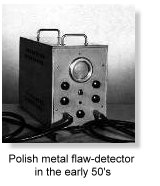 Poland was one of the several countries where ultrasonic development had started with the initial use of metal flaw detecters. Because of the political constitution, in the 1950s where ultrasonics had started to develop, the basic structure of research and development in Poland differs from that of the Western world in that it is solely state organised and sponsored. Every polytechnic is run by the State and has its own development section. If a research worker discovers a process which is feasible for manufacture it is taken over, developed and then passed on to one of the state owned manufacturing combines. No research is sponsored by industry as both the academic institutions and the manufacturing mechanics are government controlled. Similarly the patents of any new equipment are owned by the polytechnic and therefore by the government.
Poland was one of the several countries where ultrasonic development had started with the initial use of metal flaw detecters. Because of the political constitution, in the 1950s where ultrasonics had started to develop, the basic structure of research and development in Poland differs from that of the Western world in that it is solely state organised and sponsored. Every polytechnic is run by the State and has its own development section. If a research worker discovers a process which is feasible for manufacture it is taken over, developed and then passed on to one of the state owned manufacturing combines. No research is sponsored by industry as both the academic institutions and the manufacturing mechanics are government controlled. Similarly the patents of any new equipment are owned by the polytechnic and therefore by the government.
 The IPPT-PAN was established in 1953 on the basis of a few divisions in Department IV (Technical Sciences) of the Polish Academy of Sciences. During the consecutive stages of organization the basic core of the Institute was formed by divisions carrying on research in the following fields: mechanics of continuous media, mechanics of structures and materials, fluid mechanics, physical acoustics and ultrasonics, mechanical systems and electromagnetic waves. Throughout its history Institute has had an important influence on the development of research in basic technical disciplines in Poland.
The IPPT-PAN was established in 1953 on the basis of a few divisions in Department IV (Technical Sciences) of the Polish Academy of Sciences. During the consecutive stages of organization the basic core of the Institute was formed by divisions carrying on research in the following fields: mechanics of continuous media, mechanics of structures and materials, fluid mechanics, physical acoustics and ultrasonics, mechanical systems and electromagnetic waves. Throughout its history Institute has had an important influence on the development of research in basic technical disciplines in Poland.
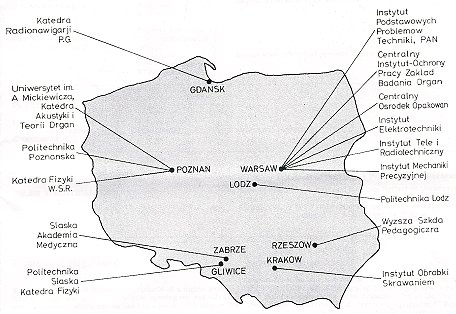
Since 1991 the budget of the Institute has been funded by the Committee of Scientific Research and supplemented by grants for particular research projects and by contracts with industrial partners for various kinds of research services. Grants and contracts with foreign partners are increasing in number and value.
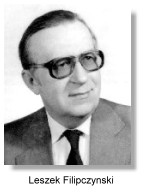 Profesor Leszek Filipczynski at the Instytut Podstawowych Problemow Techniki PAN (the Institue of Fundamental Technological Research), was one of the earliest and most important pioneers in many areas of medical ultrasonic diagnosis including neurology , ophthalmology, surgery and gynecology.
Profesor Leszek Filipczynski at the Instytut Podstawowych Problemow Techniki PAN (the Institue of Fundamental Technological Research), was one of the earliest and most important pioneers in many areas of medical ultrasonic diagnosis including neurology , ophthalmology, surgery and gynecology.
Leszek Filipczynski was an outstanding authority on acoustics, particularly on ultrasonic methods in medical diagnosis. He was the man who created the first Polish production of ultrasonographes, a man who organised the work in his Ultrasonic Department in a way that everybody - scientists, engineers and workshop workers could do their best and feel an important part of the staff. Filipczynski spent five years of the German occupation in a mechanical workshop which has been reflected in his future research work by the application of scientific discovery in practice.
After the war Filipczynski studied at three universities and took his master's degree in radiotechnical engineering. He organized together with Professor Ignacy Malecki the acoustical laboratory which was incorporated in 1953 into the Institute of Fundamental Technological Research of the Polish Academy of Sciences. Filipczynski has been associated with this institute ever since till his death, being the deputy director for scientific problems (1969-94), the general director of the institute (1969-74) as well asthe chairman of the Scientific Council (1989-93).
Leszek Filipczynski was appointed associate professor in 1957, full professor in 1962, corresponding member of the Polish Academy of Sciences in 1969, and full member in 1976. Hw was the author or editor of 12 monographs and of above 250 original papers and scientific reports published in Polish and foreign periodicals. These works concerned many basic problems in the field of ultrasonics: ultrasonic transducers, material fatigue testing, ultrasonic defectoscopy. He was pioneer in the application of ultrasonic methods in biology and medicine, among other things his works were focused on absolute methods of ultrasonic intensity measurements, ultrasonography of human organs such as brain, abdomen, eye, heart, ultrasonography of pregnant women, , a, application of ultrasonic Doppler methods in blood flow measurements, thermal effects generated by ultrasonic beams, generation and propagation as well as development of metrology of shock waves for lithotripsy and lately non-linear propagation of ultrasonic waves in soft tissues.
He promoted 10 doctorswho became continuators of his scientific activity in Poland. It should be emphasised that Professor Filipczy?ski, using his knowledge and authority, pushed forward in the home medical environment a notable group of specialist physiciansand co-organised the First International Conference UBIOMED (1970) and the Ultrasonic Section of the Polish Physician Society.
Filipczynski was awarded not only several state prizes, the last of which was the Cavalier's Cross of the Rebirth of Poland. He was recognised by the world-wide scientific authorities as pioneer in this branch, among other things he was granted by the American Institute for Ultrasonic in Medicine in Washington with the Diploma of Pioneer of Ultasonics in Medicine, in the years 1975-79 he was the vice-chairman of the European Federation for Ultrasonics in Medicine.
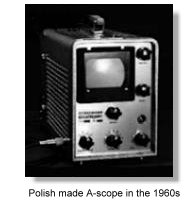 With experience in metal flaw detectors Filipczynski had started looking at its application in medical diagnosis in 1964. The first dedicated medical scanner the UG-1 was constructed and was used to examine the abdomen. In the following year with the help of colleagues I Roszkowskiego, ultrasonic investigation was applied to the field of Obstetrics and Gynaecology. Other importan co-workers included J Etienne, J Groniowski and A Firek. In 1966, the scanners EM-1 and UO-1 were produced for brain and ophthalmologic investigations. The UKG-1 was produced for the use in cardiology in 1968.
With experience in metal flaw detectors Filipczynski had started looking at its application in medical diagnosis in 1964. The first dedicated medical scanner the UG-1 was constructed and was used to examine the abdomen. In the following year with the help of colleagues I Roszkowskiego, ultrasonic investigation was applied to the field of Obstetrics and Gynaecology. Other importan co-workers included J Etienne, J Groniowski and A Firek. In 1966, the scanners EM-1 and UO-1 were produced for brain and ophthalmologic investigations. The UKG-1 was produced for the use in cardiology in 1968.
In 1967, Filipczynski and Groniowski presented their important paper "Visualization of the inside of the Abdomen by means of Ultrasonics and two methods for measuring ultrasonic doses" at the 7th International coference on Medical and Biological Engineering in Stockholm and had attracted the attentions of other investigators to the work in Poland. In 1970, Etienne and his colleagues (which included Filipczynski, Groniowski, Kretowicz, Nowicki, Roszkowski, Powalowski and Wichrzycki) published their report on the "Fetal Heart Activity Recorded by means of Ultrasound Technique". This was one of the earliest reports on a siimilar subject in the world literature.
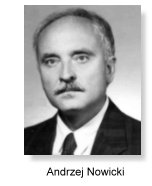 Another well-known pioneer is Professor Andrzej Nowicki, currently Professor and head of the Department of Ultrasound, Institute of Fundamental Technological Research, Polish Academy of Sciences at Warsaw.
Nowicki received his Ph.D. degree in 1976. In 1980 he received his D.Sc. degree from the Polish Academy of Sciences. He became a full Professor in 1992. Nowicki has been active in the field of medical ultrasound, research and development of the pulsed Doppler, cardiac imaging, transcranial and tissue flow Doppler and recently high frequency ultrasonic imaging. Both he and Filipczynski had been awarded the Pioneer Award in Ultrasound from the World Federation in 1988.
Another well-known pioneer is Professor Andrzej Nowicki, currently Professor and head of the Department of Ultrasound, Institute of Fundamental Technological Research, Polish Academy of Sciences at Warsaw.
Nowicki received his Ph.D. degree in 1976. In 1980 he received his D.Sc. degree from the Polish Academy of Sciences. He became a full Professor in 1992. Nowicki has been active in the field of medical ultrasound, research and development of the pulsed Doppler, cardiac imaging, transcranial and tissue flow Doppler and recently high frequency ultrasonic imaging. Both he and Filipczynski had been awarded the Pioneer Award in Ultrasound from the World Federation in 1988.
 Medical ultrasound applications and development continued into the 1970s. The UDP-1 (continous wave) and UDIMP (pulsed-wave) were produced for doppler investigations.
Medical ultrasound applications and development continued into the 1970s. The UDP-1 (continous wave) and UDIMP (pulsed-wave) were produced for doppler investigations.
With the transformation of the economy commenced in the early nineties, the "Echo-Son®" S.A. ultrasound manufacturer in Poland underwent major restructuring in 1993. The Polish Academy of Sciences, however is still the major stockholder in Echo-Son. The company is the continuation of the TECHPAN Research & Development Departament at the Institute of Fundamental Technological research (IPPT-PAN). The company started to design and manufacture Polish diagnostic ultrasound equipment in the late seventies. These included the early USG-10 for gynecology and obstetrics and the USO-10 for opthalmology. The UDT-10 was produced in 1978 for the detection of fetal pulsations.
The cardiac sectoral real-time scanner USK-40 was produced in 1984, and the computerised USG-P30 in the same year. The USG-40, a popular abdominal and Obstetric scan employing a mechanical rotary probe was manufactured in 1985. This was upgraded to the USG-50 in the following year.Transvaginal and electronic array probes were produced in the folllowing few years. Co-operation with the SonMed Company in Poland led to improved duplex doppler machines in 1994. Echo-Son now produces state-of-the-art ultrasound scanners marketed outside of Poland.
Pictures of the Polish scanners courtesy of the Department of Ultrasonics, Polish Academy of Science. Reproduced with permission.
Map of Polish centers from "Ultrasonics Research in Poland". Ultrasonics. 1967, 125-128.
Back to History of Ultrasound in Obstetrics and Gynecology.